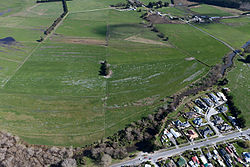Spencerville | |
|---|---|
 Spencerville and the Styx River | |
 | |
| Coordinates: 43°25′55″S 172°41′50″E / 43.432042°S 172.697250°E | |
| Country | New Zealand |
| Region | Canterbury |
| Territorial authority | Christchurch City |
| Ward | Coastal |
| Community | Waitai Coastal-Burwood-Linwood |
| Electorates |
|
| Government | |
| • Territorial Authority | Christchurch City Council |
| • Regional council | Environment Canterbury |
| • Mayor of Christchurch | Phil Mauger |
| • Christchurch East MP | Reuben Davidson |
| • Te Tai Tonga MP | Tākuta Ferris |
| Area | |
• Total | 0.37 km2 (0.14 sq mi) |
| Population (June 2024)[1] | |
• Total | 600 |
| • Density | 1,600/km2 (4,200/sq mi) |
Spencerville is a semi-rural town on the east coast of Canterbury, New Zealand north of Christchurch.[2] The town backs on to Bottle Lake Forest and includes a large (1 hectare) park and 80 hectare camping ground.[2] These amenities, as well as wetlands and an animal and bird park make the town a popular camping area for Christchurch residents.[3][4]
After the 2011 Christchurch earthquake, the New Zealand Government classified Spencerville land as Technical Category T3.[5] This requires repairers, builders and developers to meet stricter building standards.[5]
Demographics
[edit]Spencerville is defined by Statistics New Zealand as a rural settlement. It covers 0.37 km2 (0.14 sq mi)[6] and had an estimated population of 600 as of June 2024,[1] with a population density of 341 people per km2. It is part of the larger Brooklands-Spencerville statistical area.
| Year | Pop. | ±% p.a. |
|---|---|---|
| 2006 | 576 | — |
| 2013 | 507 | −1.81% |
| 2018 | 513 | +0.24% |
| Source: [7] | ||
Before the 2023 census, the settlement had a smaller boundary, covering 0.34 km2 (0.13 sq mi).[6] Using that boundary, Spencerville had a population of 513 at the 2018 New Zealand census, an increase of 6 people (1.2%) since the 2013 census, and a decrease of 63 people (−10.9%) since the 2006 census. There were 165 households, comprising 264 males and 255 females, giving a sex ratio of 1.04 males per female, with 111 people (21.6%) aged under 15 years, 108 (21.1%) aged 15 to 29, 249 (48.5%) aged 30 to 64, and 45 (8.8%) aged 65 or older.
Ethnicities were 91.2% European/Pākehā, 13.5% Māori, 4.1% Pasifika, 4.1% Asian, and 2.9% other ethnicities. People may identify with more than one ethnicity.
Although some people chose not to answer the census's question about religious affiliation, 56.7% had no religion, 34.5% were Christian, 0.6% were Hindu, 0.6% were Buddhist and 2.3% had other religions.
Of those at least 15 years old, 90 (22.4%) people had a bachelor's or higher degree, and 60 (14.9%) people had no formal qualifications. 69 people (17.2%) earned over $70,000 compared to 17.2% nationally. The employment status of those at least 15 was that 213 (53.0%) people were employed full-time, 87 (21.6%) were part-time, and 15 (3.7%) were unemployed.[7]
Brooklands-Spencerville statistical area
[edit]Brooklands-Spencerville statistical area, which also includes Brooklands, covers 7.25 km2 (2.80 sq mi).[6] It had an estimated population of 800 as of June 2024,[8] with a population density of 110 people per km2.
| Year | Pop. | ±% p.a. |
|---|---|---|
| 2006 | 1,746 | — |
| 2013 | 1,134 | −5.98% |
| 2018 | 735 | −8.31% |
| Source: [9] | ||

Brooklands-Spencerville had a population of 735 at the 2018 New Zealand census, a decrease of 399 people (−35.2%) since the 2013 census, and a decrease of 1,011 people (−57.9%) since the 2006 census. There were 240 households, comprising 372 males and 366 females, giving a sex ratio of 1.02 males per female. The median age was 39.7 years (compared with 37.4 years nationally), with 144 people (19.6%) aged under 15 years, 156 (21.2%) aged 15 to 29, 369 (50.2%) aged 30 to 64, and 66 (9.0%) aged 65 or older.
Ethnicities were 89.4% European/Pākehā, 11.8% Māori, 2.9% Pasifika, 5.3% Asian, and 2.4% other ethnicities. People may identify with more than one ethnicity.
The percentage of people born overseas was 19.6, compared with 27.1% nationally.
Although some people chose not to answer the census's question about religious affiliation, 55.9% had no religion, 32.2% were Christian, 0.4% were Hindu, 0.4% were Buddhist and 1.6% had other religions.
Of those at least 15 years old, 111 (18.8%) people had a bachelor's or higher degree, and 99 (16.8%) people had no formal qualifications. The median income was $36,000, compared with $31,800 nationally. 96 people (16.2%) earned over $70,000 compared to 17.2% nationally. The employment status of those at least 15 was that 315 (53.3%) people were employed full-time, 129 (21.8%) were part-time, and 18 (3.0%) were unemployed.[9]
References
[edit]- ^ a b "Aotearoa Data Explorer". Statistics New Zealand. Retrieved 26 October 2024.
- ^ a b "Community profile – Styx" (PDF). Christchurch City Council. November 2014. Retrieved 19 January 2021.
- ^ "Spencer Park and Brooklands Lagoon" (PDF). Christchurch City Council. 2016. Retrieved 19 January 2021.
- ^ Wright, Michael (5 January 2012). "Holidaymakers brush off quake fears". Stuff. Retrieved 19 January 2021.
- ^ a b Wright, Michael (9 April 2012). "Council turns down red-zone land deal". Stuff. Retrieved 19 January 2021.
- ^ a b c "ArcGIS Web Application". statsnz.maps.arcgis.com. Retrieved 6 September 2021.
- ^ a b "Statistical area 1 dataset for 2018 Census". Statistics New Zealand. March 2020. 7024286, 7024287 and 7024288.
- ^ "Aotearoa Data Explorer". Statistics New Zealand. Retrieved 26 October 2024.
- ^ a b "Statistical area 1 dataset for 2018 Census". Statistics New Zealand. March 2020. Brooklands-Spencerville (317100). 2018 Census place summary: Brooklands-Spencerville